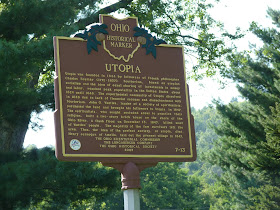 |
| from wikipedia |
The Fourier communes were called phalanxes, and each had a large central hall called the "phalansteres". In these buildings, which were usually four floors, the richer members got the fourth floors and the poorer you were the lower the floor assigned to you. One of Fourier's more bizarre beliefs was that the seas would one day turn from salt water to lemonade! He was ahead of his time in other areas of thought however, a proponent of women's rights and a believer in the freedom of people to marry or love whom they pleased, be it of the opposite or same sex. For a fee of $25, one could gain entrance to this community along with a small wooden house.
Fourier passed away in 1837, seven years before the establishment of the Utopia phalanx in southeastern Ohio. The settlers built a large, thirty-room building and several other buildings out of brick, but their experiment lasted only two years. Problems with cash flow, interpersonal differences, and probably the frontier terrain that confronted them proved too much and the phalanx was abandoned.
| from the History Ring |
Whatever his spiritual leanings, he and his followers decided to move the large 30-room brick building built by the Utopians to the very banks of the Ohio. Locals warned them of the danger of floods; this was before the locks and dams system and the Ohio had devastating floods regularly. These new settlers paid no heed to warnings but went ahead with their building, moving it brick by brick. It had not been completed but a short time before the river did indeed flood on December 13, 1847. According to local lore, there were over 150 people in the building at the time of the flood. Community members had gone to the building, some by boat, to seek shelter from the waters, but almost all of them lost their lives. Only six survived. Was Wattles there at the time of the flood? I do not know. If he was, he was one of the survivors as he died in Kansas in 1859
The property was then acquired by Josiah Warren; he established yet another intentional community that continued to operate more or less successfully although by 1875 only a few of the settler's remained in the place they had renamed Smith's Landing. The name of Utopia was later restored by the Ohio Historical Society, and a sign with a brief history of the settlement was erected in 2003.
 |
| One of the few businesses left in Utopia |
Today there is little to see in Utopia. A few scattered houses and the sign are about all there is. Well, those and the spirits that apparently roam the area at night, when the fog and the mists rise from the Ohio
You can read more about Utopia here and here.
Copyright Susanna Holstein. All rights reserved. No Republication or Redistribution Allowed without attribution to Susanna Holstein.



You amaze me!
ReplyDeleteSuch a diversity of blog writing-so talented!!! Hard worker! Congrats!!